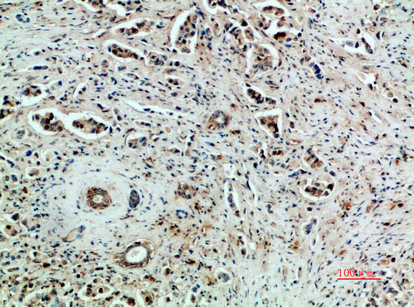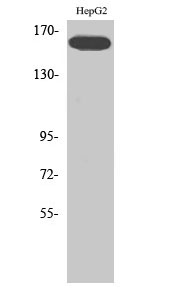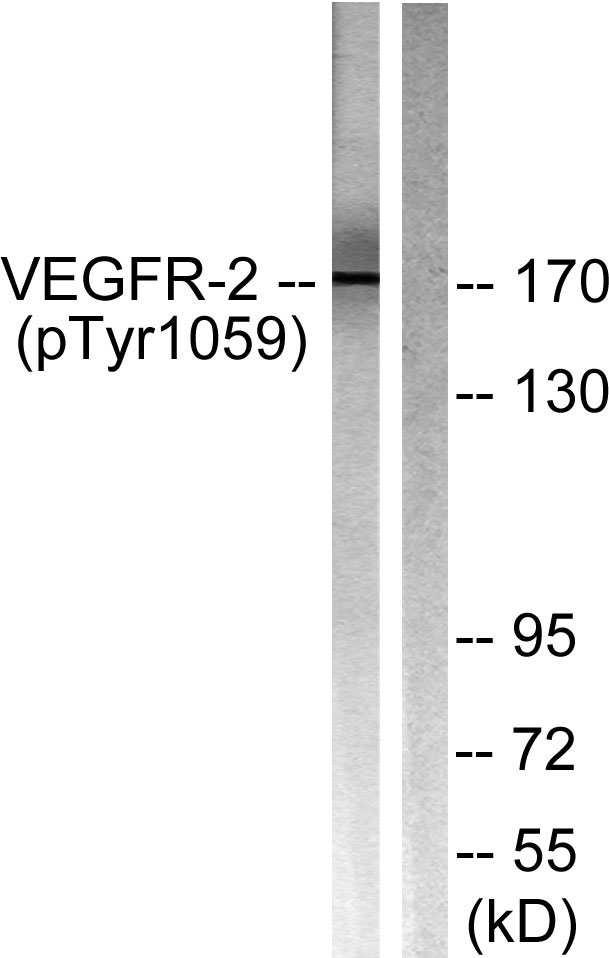Flk-1/VEGFR2 Polyclonal Antibody
- Catalog No.:YT5845
- Applications:IF;WB;IHC;ELISA
- Reactivity:Human;
- Target:
- Flk-1/VEGFR2
- Fields:
- >>EGFR tyrosine kinase inhibitor resistance;>>MAPK signaling pathway;>>Ras signaling pathway;>>Rap1 signaling pathway;>>Calcium signaling pathway;>>PI3K-Akt signaling pathway;>>VEGF signaling pathway;>>Focal adhesion;>>Proteoglycans in cancer;>>Fluid shear stress and atherosclerosis
- Gene Name:
- KDR FLK1 VEGFR2
- Protein Name:
- VEGFR2
- Human Gene Id:
- 3791
- Human Swiss Prot No:
- P35968
- Mouse Swiss Prot No:
- P35918
- Rat Swiss Prot No:
- O08775
- Immunogen:
- Synthetic peptide from human protein at AA range: 1268-1341
- Specificity:
- The antibody detects endogenous VEGFR2
- Formulation:
- Liquid in PBS containing 50% glycerol, 0.5% BSA and 0.02% sodium azide.
- Source:
- Polyclonal, Rabbit,IgG
- Dilution:
- IF 1:50-200 WB 1:500 - 1:2000. IHC: 1:100-300 ELISA: 1:20000. Not yet tested in other applications.
- Purification:
- The antibody was affinity-purified from rabbit antiserum by affinity-chromatography using epitope-specific immunogen.
- Concentration:
- 1 mg/ml
- Storage Stability:
- -15°C to -25°C/1 year(Do not lower than -25°C)
- Other Name:
- Vascular endothelial growth factor receptor 2 (VEGFR-2;EC 2.7.10.1;Fetal liver kinase 1;FLK-1;Kinase insert domain receptor;KDR;Protein-tyrosine kinase receptor flk-1;CD antigen CD309)
- Molecular Weight(Da):
- 152kD
- Background:
- Vascular endothelial growth factor (VEGF) is a major growth factor for endothelial cells. This gene encodes one of the two receptors of the VEGF. This receptor, known as kinase insert domain receptor, is a type III receptor tyrosine kinase. It functions as the main mediator of VEGF-induced endothelial proliferation, survival, migration, tubular morphogenesis and sprouting. The signalling and trafficking of this receptor are regulated by multiple factors, including Rab GTPase, P2Y purine nucleotide receptor, integrin alphaVbeta3, T-cell protein tyrosine phosphatase, etc.. Mutations of this gene are implicated in infantile capillary hemangiomas. [provided by RefSeq, May 2009],
- Function:
- catalytic activity:ATP + a [protein]-L-tyrosine = ADP + a [protein]-L-tyrosine phosphate.,function:Receptor for VEGF or VEGFC. Has a tyrosine-protein kinase activity. The VEGF-kinase ligand/receptor signaling system plays a key role in vascular development and regulation of vascular permeability. In case of HIV-1 infection, the interaction with extracellular viral Tat protein seems to enhance angiogenesis in Kaposi's sarcoma lesions.,similarity:Belongs to the protein kinase superfamily. Tyr protein kinase family.,similarity:Belongs to the protein kinase superfamily. Tyr protein kinase family. CSF-1/PDGF receptor subfamily.,similarity:Contains 1 protein kinase domain.,similarity:Contains 7 Ig-like C2-type (immunoglobulin-like) domains.,subunit:Interacts with MYOF (By similarity). Interacts with SHB; upon VEGF activation. Interacts with HIV-1 Tat.,
- Subcellular Location:
- Cell junction . Endoplasmic reticulum . Cell membrane . Localized with RAP1A at cell-cell junctions (By similarity). Colocalizes with ERN1 and XBP1 in the endoplasmic reticulum in endothelial cells in a vascular endothelial growth factor (VEGF)-dependent manner (PubMed:23529610). .; [Isoform 1]: Cell membrane; Single-pass type I membrane protein. Cytoplasm. Nucleus. Cytoplasmic vesicle. Early endosome. Detected on caveolae-enriched lipid rafts at the cell surface. Is recycled from the plasma membrane to endosomes and back again. Phosphorylation triggered by VEGFA binding promotes internalization and subsequent degradation. VEGFA binding triggers internalization and translocation to the nucleus.; [Isoform 2]: Secreted .; [Isoform 3]: Secreted.
- Expression:
- Detected in cornea (at protein level). Widely expressed.
Marine bromophenol bis(2,3-dibromo-4,5-dihydroxybenzyl) ether, represses angiogenesis in HUVEC cells and in zebrafish embryos via inhibiting the VEGF signal systems. BIOMEDICINE & PHARMACOTHERAPY 2015 Sep 07 WB Human HUVECs
Marine bromophenol bis (2, 3-dibromo-4, 5-dihydroxybenzyl) ether, represses angiogenesis in HUVEC cells and in zebrafish embryos via inhibiting the VEGF signal systems." Biomedicine & Pharmacotherapy 75 (2015): 58-66.
Li, Na, et al. "Asparaginyl endopeptidase may promote liver sinusoidal endothelial cell angiogenesis via PI3K/Akt pathway." Revista espanola de enfermedades digestivas: organo oficial de la Sociedad Espanola de Patologia Digestiva111 (2018).
Acute hypoxia promotes the liver angiogenesis of largemouth bass (Micropterus salmoides) by HIF - Dependent pathway FISH & SHELLFISH IMMUNOLOGY Liulan Zhao WB,IHC Fish
Tetrahedral framework nucleic acids inhibit pathological neovascularization and vaso-obliteration in ischaemic retinopathy via PI3K/AKT/mTOR signalling pathway CELL PROLIFERATION Xiaoyan Ding IF,WB Human human umbilical vein endothelial cells (HUVECs)
Gualou Guizhi decoction promotes therapeutic angiogenesis via the miR210/HIF/VEGF pathway in vivo and in vitro. Lihong Nan WB Rat,Human Ischemic brain tissue Human umbilical vein endothelial cell (HUVEC)
Kaempferol inhibited invasion and metastasis of gastric cancer cells by targeting AKT/GSK3β pathway based on network pharmacology and molecular docking JOURNAL OF ASIAN NATURAL PRODUCTS RESEARCH Xia-Qing Gao WB Human 1:1000 HGC27 cell,MKN45 cell
- June 19-2018
- WESTERN IMMUNOBLOTTING PROTOCOL
- June 19-2018
- IMMUNOHISTOCHEMISTRY-PARAFFIN PROTOCOL
- June 19-2018
- IMMUNOFLUORESCENCE PROTOCOL
- September 08-2020
- FLOW-CYTOMEYRT-PROTOCOL
- May 20-2022
- Cell-Based ELISA│解您多样本WB检测之困扰
- July 13-2018
- CELL-BASED-ELISA-PROTOCOL-FOR-ACETYL-PROTEIN
- July 13-2018
- CELL-BASED-ELISA-PROTOCOL-FOR-PHOSPHO-PROTEIN
- July 13-2018
- Antibody-FAQs
- Products Images

- Immunohistochemical analysis of paraffin-embedded human-breast-cancer, antibody was diluted at 1:200

- Immunohistochemical analysis of paraffin-embedded human-placenta, antibody was diluted at 1:200



